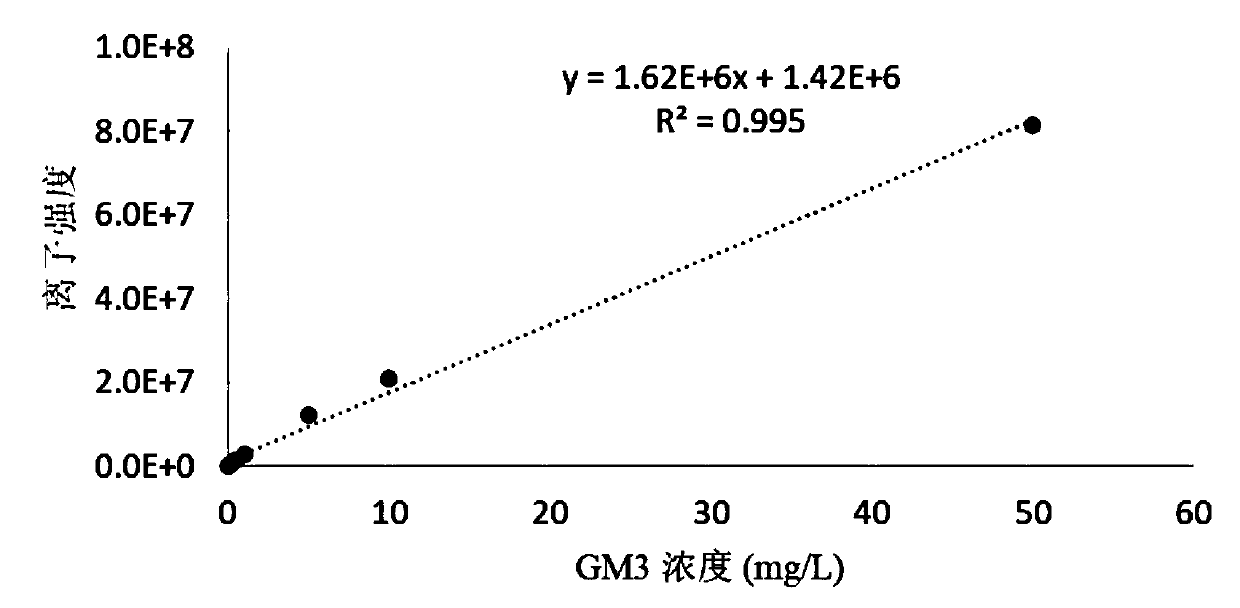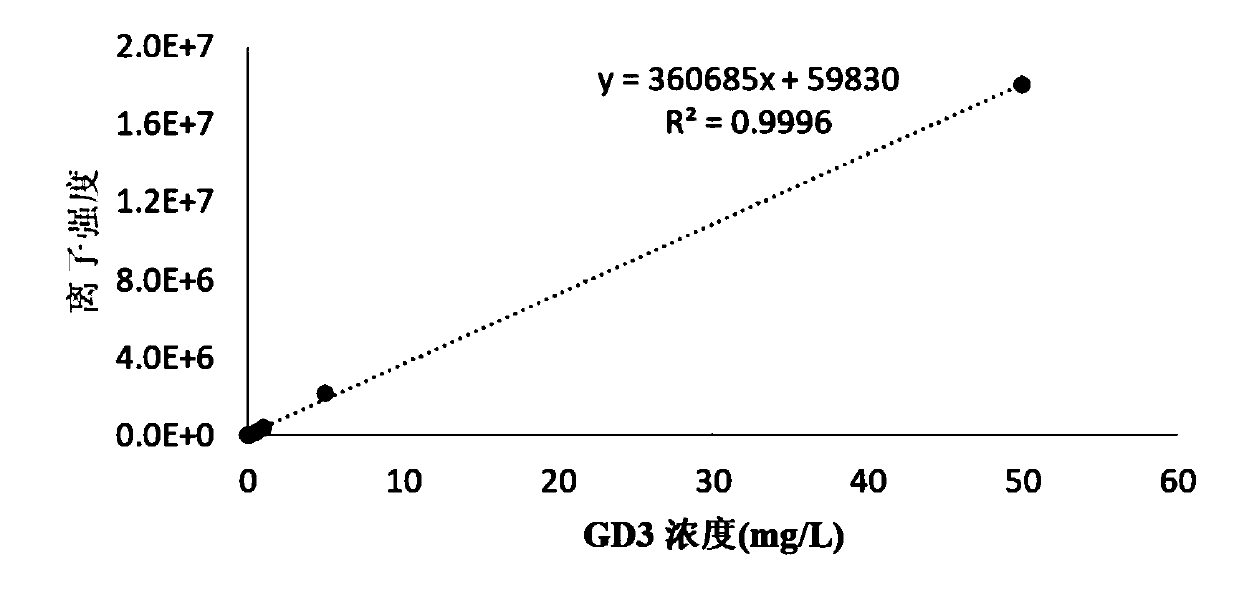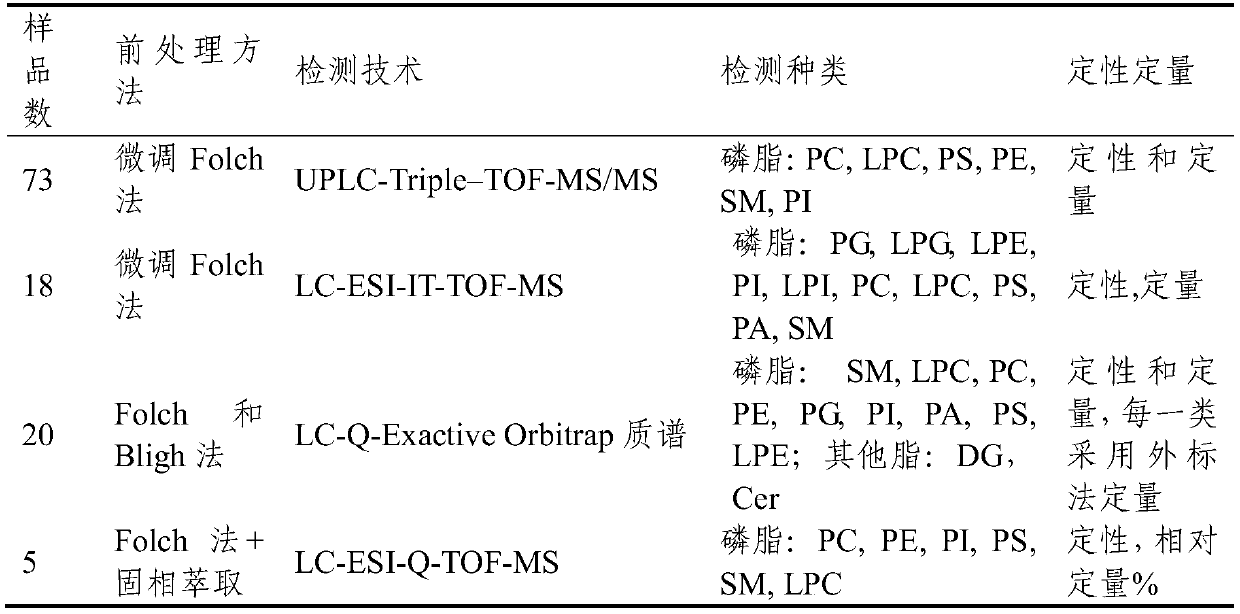Food lipid extraction method and detection method of lipid in food
A food and lipid technology, applied in the field of food extraction and detection, can solve the problems of large sample usage, time-consuming, material consumption, etc., and achieve the effects of efficient extraction and separation, improved safety, and less sample consumption.
- Summary
- Abstract
- Description
- Claims
- Application Information
AI Technical Summary
Problems solved by technology
Method used
Image
Examples
Embodiment 1
[0123] Example 1: Breast milk glycerides, fatty acids, phospholipids and gangliosides were extracted separately
[0124] 1 Sample pretreatment
[0125]1# tube: 200μL breast milk + 200μL ultrapure water + 1.8mL methanol + 800μL dichloromethane (chromatographically pure) → manual shaking for 10 seconds, ultrasonication for 5min → add 200μL ultrapure water + 800μL dichloromethane (chromatographically pure) → hand Shake well and oscillate for 10s→centrifuge at 6000r / min for 15min→take out the lower organic phase and transfer it to 2# tube→
[0126] 1) Upper layer of 1# tube + 1.6mL dichloromethane → centrifuge, 6000r / min, 15min → take out the lower organic phase to 3# tube
[0127] 2) The lower organic phase in 2# tube + 1mL ultrapure water + 2.2mL methanol + 0.6mL dichloromethane, shake manually → centrifuge, 3000g / min, 10min → take out the lower organic phase and mix it in 3# tube → blow dry with nitrogen → Dissolve in 1ml of dichloromethane:methanol (v / v=2:1) for solid phas...
Embodiment 2
[0145] Embodiment 2 extracts breast milk lipid simultaneously
[0146] 1 Sample pretreatment
[0147] 80uL breast milk + 1200uL ultra-pure water + 2.5mL methanol + 1200uL dichloromethane (chromatographically pure) → shake manually for 10 seconds, let stand for 30min → add 1.5mL ultrapure water + 1mL dichloromethane (chromatographically pure) → shake manually Shake for 10S→centrifuge, 6000r / min, 15min→take out the lower organic phase→upper layer+1.6mL dichloromethane→centrifuge, 6000r / min, 15min→take out the lower organic phase and mix with the previous organic phase→dry with nitrogen→250uL 10mmol / Dissolve in L ammonium acetate (v / v, dichloromethane:methanol=1:1) solution → centrifuge, 6000r / min, 5min.
[0148] 2 using Kinetex C18 Column (150mm×4.6mm, 2.6μm; Phenomenex, Torrance, CA, USA) chromatographic column, column temperature 40℃, liquid phase gradient elution
[0149] The liquid phase elution gradient of table 6 embodiment 2
[0150]
[0151] 3 Mass Spectrometry ...
Embodiment 3
[0155] Example 3 Breast milk glycerides / fatty acids / phospholipids and gangliosides were extracted separately and detected twice
[0156] 1 Sample pretreatment
[0157] 100 μL of breast milk to 1# tube + 150 μL ultrapure water + 1.5 mL methanol + 800 μL dichloromethane (chromatographically pure) → manual shaking for 10 seconds, ultrasonication for 5 minutes → add 200 μL ultrapure water + 800 μL dichloromethane (chromatographically pure) → hand Shake well and oscillate for 10S→centrifuge at 6000r / min for 15min→take out the upper phase and transfer to 2# tube:
[0158] Step 1: 2# tube + 1.6mL dichloromethane → centrifuge, 6000r / min, 15min → take out the upper phase to 3# tube, wait to mix with the upper phase taken out in step 2
[0159] Step 2: The remaining organic phase in 1# tube + 2mL methanol + 0.8mL dichloromethane + 1mL ultrapure water → centrifuge, 6000r / min, 15min → take out the upper phase and mix it with the upper layer of 3# tube in step 1, the upper phase Direct f...
PUM
 Login to View More
Login to View More Abstract
Description
Claims
Application Information
 Login to View More
Login to View More - R&D
- Intellectual Property
- Life Sciences
- Materials
- Tech Scout
- Unparalleled Data Quality
- Higher Quality Content
- 60% Fewer Hallucinations
Browse by: Latest US Patents, China's latest patents, Technical Efficacy Thesaurus, Application Domain, Technology Topic, Popular Technical Reports.
© 2025 PatSnap. All rights reserved.Legal|Privacy policy|Modern Slavery Act Transparency Statement|Sitemap|About US| Contact US: help@patsnap.com



